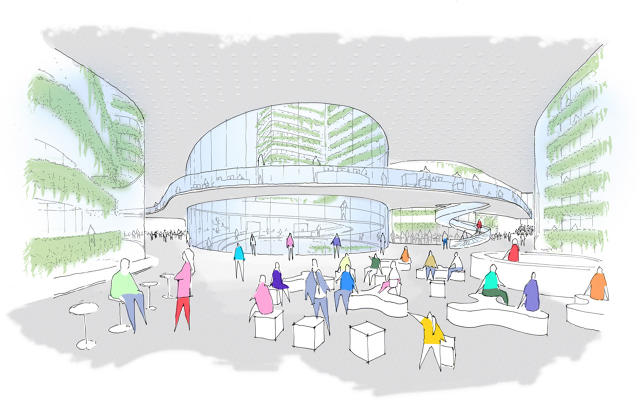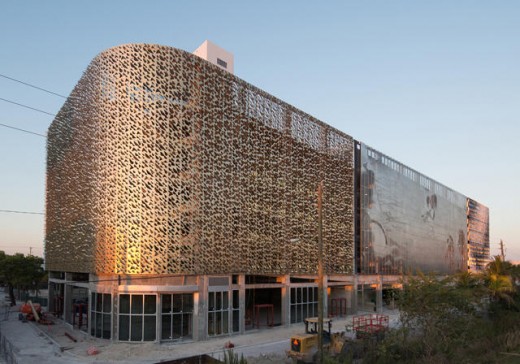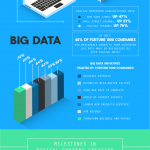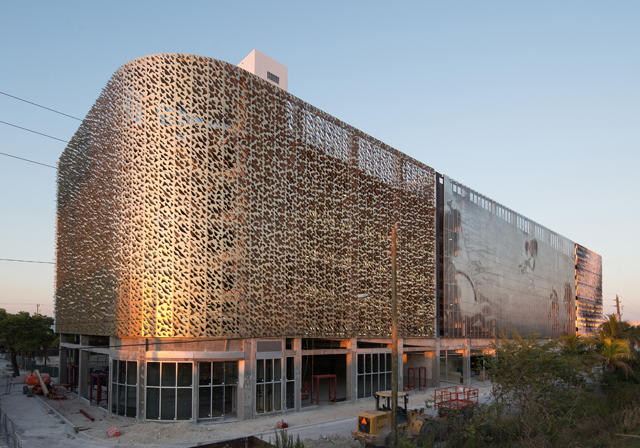can you Design Innovation?
Innovation districts are stoning up everywhere the usa. but will they work?
August 18, 2015
picture a glowing building wrapped round an expansive tree-crammed courtyard. all of the walls are glass so you will see what’s going down in the ground-level retail and open-plan workplaces on the higher flooring. In lieu of cramped hallways there are wide-open walkways and a snaking ramp that ascends to a rooftop garden. residences are close through and there is a consistent hum of activity and interplay all over. this is the picture of a impending innovation district in Miami, Florida.
In business, people are racing to enhance the following large thing. in a similar way, cities and developers are capitalizing on this by constructing whole neighborhoods to foster innovation. however one query lies on the coronary heart of the development: Can innovation in reality be designed?

Innovation Districts, outlined
Planners have cycled thru more than a few city building fashions over the decades. New Urbanism, good growth, and Transit Oriented building, as an example, have fallen in and out of fashion. although they’ve formally existed for over a decade, innovation districts have generated substantial momentum recently.
22@ in Barcelona, which broke ground in 2000, was once one of the first commercially developed, city-certain innovation districts. Joan Clos, the city’s former mayor, lead the initiative to turn out to be a derelict 494-acre industrial zone into a tech hub. Strategically situated near Barcelona Activa, a industry incubator, the purpose was to provide area for corporations to “graduate” into. The master plan was once a hit. on account that 2000, 4,500 companies new companies entered the district, 47% of which are startups and 27% are regarded as information-intensive businesses. Scytl, an electronic vote casting company, emerged from the regional and is one of the most a success startups from the district. The body of workers in the regional has grown 62% and it’s house to hundreds of residential gadgets, walkable streets, and academic establishments. 22@’s success proved the innovation district adaptation can yield a hit city building.
transferring stateside, Seaport square, in Boston, used to be some of the first floor-up innovation districts, which was special in 2010 by means of mayor Thomas Menino. In 2014 efforts to build new ones hit a fever pitch with cities from coast to coast approving master plans. Innovation districts are underway in Brooklyn, Chicago, Portland, San Francisco, Fremont, and Seattle. There are established innovation districts in cities that encompass Tier 1 research universities, like Cambridge, Massachusetts (MIT and Harvard); Atlanta (Georgia Tech); and Pittsburgh (Carnegie-Mellon).
An innovation district can be planned from the bottom up or areas inside cities can evolve into one. At its broadest, an innovation district is composed of slicing-edge research (frequently from of an immense academic establishment), industry incubators, startups, evolved technical networking, industrial areas, housing, transit accessibility, social areas, and amenities. It goes past time-honored “combined use” building to embody a recipe of specific attributes that, in thought, fuel innovation. moreover, the whole thing is packed into a dense house.
the speculation is that when you mix all this stuff together, people, who in the outdated version of city building may stay siloed, have the option to mingle. And being the social creatures that they are, then spark conversations with these out of doors of their direct self-discipline and probably come up with implausible new ideas. In thought, innovation districts are the antithesis of the remoted trade parks and company campuses that define Silicon Valley.
What Does An Innovation District appear to be?
while the composition of an innovation district is more or less set, its bodily presence is extra ambiguous. The common subject matters, on the other hand, are transparency, versatile areas, and opportunities for folk to spontaneously meet. that is the place the hand of the architect enters the fold.
Bruce Katz, is the vice president and director of the Metropolitan policy software on the Brookings Institute and co-writer of a paper titled “the upward thrust of Innovation Districts.” he is spent the last few years traveling the united states and discovering this burgeoning city adaptation. whereas Katz primarily analyzes data and figures—the quantifiable financial indications of innovation—he additionally retains an eye fixed on design. “my very own view is that design and structure subject moderately a bit, however it doesn’t necessarily in truth,” he says.
To Katz, essentially the most a hit districts promote the “bump and mingle” effect. inside of, the spaces are versatile and accommodate coworking and collaboration. out of doors, the general public spaces are animated and bright, whether or not its from pop-united statesor public applications or only a welcoming area. “i wouldn’t call it all ‘high design’ however giving a sense that it’s a vacation spot and a cool situation to work is tactical urbanism to one of the best level.”
In Boston, Hacin + associates was commissioned to build District hall, the flagship structure within the 23-acre Seaport sq. innovation district situated on the town’s waterfront. together with the new York–based agency Kohn Pedersen Fox, Hacin + associates also developed the site’s master plan.

“Innovation districts wouldn’t have precedents for building type,” Scott Thomson, a senior associate at Hacin + associates and District hall’s mission manager, says. At 12,000 square feet, District hall properties a restaurant and cafe, versatile meeting and assembly areas, and workspaces. It also hosts seminars and occasions.
“Design was a very powerful a part of the constructing on the grounds that it would be a symbol of the district,” Thomson says. “It wanted to get the purpose across of concepts coming together to begin one thing new. What was once a shiny district in regards to the import and export of products is now about the import and export of ideas.”
The constructing is as much about metaphors as becoming a beacon for the burgeoning district. huge expanses of glass offer transparency into the structure and invite a dialog with the city. The finishes—like corrugated metallic cladding and concrete floors—and silhouette nod to the website online’s industrial prior. concept Paint coats the partitions inside to welcome impromptu word taking and punchy colors—like chartreuse, the unofficial coloration of disruption—liven up the rooms. portable furniture encourages folks to carve out their own spaces.
whereas the sleek design seems like a tech startup hallmark, it serves a measured goal: luring a certain form of person to the district and forging an area they wish to inhabit. “The consumers the city is attempting to draw lends itself to having a certain design ethos in the district and the structures themselves,” Thomson says. “plenty of what occurs here is fundamentally creative.”
Katz notes that there’s a better cultural shift towards open innovation in play. companies don’t seem to be conducting analysis and building internally, he says, they’re searching for ideas anyplace they may be able to get them.
nowadays’s wellspring of latest analysis incessantly comes because of universities, which benefit from federal delivers and have get entry to to tools and tools that the average industry does not. Intermediaries, like startups and entrepreneurs, release these ideas and bring them to market. “if you want to build an financial system, get an advanced research university to maneuver in and wait 50 years,” Katz says. Kendall square, in Cambridge, Massachusetts, is a a hit innovation district to Katz; college city in Philadelphia, which is anchored with the aid of Drexel college and the college of Pennsylvania, is any other one.
Katz points out that universities—anchors for innovation districts—are starting to de-centralize, as an instance Cornell’s new tech campus on Roosevelt Island and u.s.a.’s Mission Bay outpost. “that is where structure and design can lend a hand,” he says. “As these institutions move around, how can they be designed to welcome open innovation?”
should you construct It, Will they come?
This summer, the brand new York-based totally architecture agency shop, Dutch landscape structure firm West eight, and developer Michael Simkins printed renderings for the aforementioned innovation district within the Park West regional of Miami, Florida.

“We’re making an attempt onerous to verify it can be no longer a buzzword, that it’s a real factor,” Vishaan Charkrabarti, a main at store, says.
This is not the first time shop has labored on an innovation-oriented venture. Its Botswana Innovation Hub, in Gaborone, is currently beneath development. The 300,000-square-foot venture properties an HIV analysis lab run by the Ministry of health in partnership with Baylor, Harvard, and the university of Pennsylvania alongside industrial spaces.

“The us of a has a small inhabitants and is neatly educated,” William Sharples, also a fundamental at shop, says. “Its primary exports are red meat and diamonds and the Hub is helping to take the united states of america into the subsequent millennium. Working with the international Finance Committee inside the World bank, we recognized the essential elements to have something the place innovation and creativity can happen: research, biotech, knowledge and verbal exchange expertise, an instructional relationship, and business opportunities. it can be a microcosm of what everybody’s speaking about once they talk about innovation districts and various those elements play into Miami.”
The Park West construction is about 10 acres large—the dimensions of 4 city blocks. The designers conceived of the grasp plan as an urban campus with shared public plazas, three,850,000 square ft of place of business house, 2,400,000 sq. feet of residential area, and 250,000 square feet of retail. Walkways and shared corridors link the whole lot collectively. keep tasks that the improvement will bring 13,000 excessive-paying jobs to Miami.
“We focus on the physical prerequisites wanted to facilitate ‘serendipitous encounters,'” Charkrabarti says. “it’s about constructing in a dense, highly walkable surroundings—an urban incubator.”
store calls the innovation district radical blended use and helps developing structures that may adapt over time to suit the desires of whomever makes use of them. it’s flexibility and toughness by using design. The agency acknowledges that de novo cities hardly seem to be right on day one, and they require time to get their footing and turn into populated.
“it can be not about putting individuals beneath a Bucky Fuller dome,” Chakrabarti says. “it’s about reinventing cities and infrastructure so folks aren’t in these twentieth-century bubbles, segregated bodily, socially, and technically.”
“Millennials don’t want to be prescribed,” Sharples provides. “you need to provide them a platform the place they may be able to development—it can be about getting the right components in situation and having the precise constructing techniques and infrastructure to improve them.”
What keep calls the Miami Innovation Tower is the advance’s marquee construction. The controversial 633-foot-tall torqued kind is able to exhibiting photography, due to digital billboards integrated into its pores and skin, and proclaims the district’s goal as a expertise-oriented local. And whereas a veritable 63-story display speaks the district’s character, so do the challenge’s tree-lined streets and sidewalks.

“In a technological generation, we wish to walk more and be in contemplative environments,” Charkrabarti says. “You get so distracted with the aid of tech that in an effort to innovate you need to step again and take a breather. You need nature.”
To that end, the Miami District has abundant inexperienced house on more than one ranges, including on the roof. What’s additionally outstanding in regards to the conceptual drawings is the presence of pedestrians all over. The grasp plan is built across the human scale and velocity, now not cars, and to buy their vision for an innovation district is emblematic of a new course in metropolis building.
To Sharples, the design of the district is symbolic of what people need from their cities: a place the place it’s simple to live their lives and that’s the reason obtainable on various ranges. Housing, a challenge in large cities, is a big part of the innovation district as it includes micro-devices focused to the personnel its expected to beef up. “not everything must be about a govt application to have reasonably priced housing” Sharples says. “there’s also a duty about infrastructure to make affordable neighborhoods available. If individuals can live near the place they work, there is an enormous time financial savings. In a provider economy, time is the most precious useful resource.”
towards a brand new structure
whereas the twentieth-century city used to be built around vehicles, the town of the future will probably be tailor-made to individuals.
“for those who take a look at the way forward for the city where we’re riding less, that you can start scaling metropolis blocks not around the turning radius of an 18-wheeler however to the turning radius of a 3-wheel electrical vehicle,” Chakrabarti says. “You start generating side road grids we haven’t viewed before the arrival of the automobile. it can be an absolutely totally different paradigm from the 20th century the place you thought about the highway, the campus 10 miles from downtown and 20 miles from your home.”

whereas investment in city type and making a spot appear beautiful and engaging appears subjective, it can be changing into a mighty driver for boom. As shoppers, we’re turning into savvier about what’s round us and extra a professional about design. while we encompass ourselves with merchandise that fulfill a particular aesthetic or expectation or expertise, what we demand from cities will is also becoming more sophisticated. to put it bluntly: all these Apple fanboys and girls will need a city to match.
in the context of creating a successful innovation district or a design district, populating it with a definite type of person is the essential component. Design can undoubtedly foster those connections, nevertheless it goes past appears. especially, a district needs to work and fulfill the needs of its denizens—it is about experimenting with visionary models for cities and how design can facilitate it.
“in the 20th century, education, expertise, and culture were thought of as ‘etcetera’—great Christmas ornaments,” Chakrabarti says. “now we have to take into accounts it in reverse, that they power city growth.”

A an identical philosophy of walkability and proximity governs every other large-scale local regional building, the Miami Design District spearheaded by developer Craig Robins. Geared toward arts and culture, the conclusion that design issues is extra clear reduce. whereas the form of the innovation and design districts have their very own flavors, the composition is sort of an identical: walkable streets, open house, residences, structures constructed to the human scale, business storefronts, industry, and a big institution (in the Design District’s case, the Institute of recent art Miami). And just like the Miami Innovation District, it has a roster of huge identify architects steering the general design, like Studio Gang, Sou Fujimoto, and Aranda Lasch, to name just a few.
“To have a fertile creative environment, we have now to have interesting architecture,” Robins says. “in a roundabout way, it can be a query of the quality of life and when there’s a better sensitivity to design and art and the inventive course of, i feel issues are better. once we speak about neighborhoods, they can be for anything else. A regional so one can achieve success could have an smart urban design first.”
both Robins’s district and shop’s are built round similar modern urban design tenets—nevertheless it’s who strikes in that will not directly deem them successes.

All in a name?
On paper, an innovation district sounds like a win-win for cities and builders. spend money on a website online and reap the the profit from building a multi-million-greenback construction or increase the job drive and improve financial health. on the other hand, the aspiration towards innovation is not a guarantee for results.
Katz cautions against calling a nearby an innovation district when it doesn’t have the bona fides. “that is an idea virus,” he says of the rapid proliferation of builders claiming they’ve constructed innovation districts. He says the proper function of an innovation district is idea technology and the commercialization of analysis. When he analyzes an innovation district, he bases it on economic factors, not on floor characteristics. “this can be a market dynamic, no longer a executive software or a real estate gimmick,” he says. “Labeling one thing as modern does not essentially make it so.”
The media has nicknamed some of the innovation hubs world wide which can be looking to replicate Silicon Valley’s unbridled success. there may be Silicon seaside, in l. a.; Silicon Alley, in manhattan; Silicon Lagoon, in Nigeria; Silicon Savannah, in Kenya; and Silicon Plateau, in India. The aspiration is certainly there, however the outcomes might not be.
Katz is at-work on an auditing tool to separate the true innovation districts from the aspirational ones. it is centered round 5 categories: a critical mass of process, connectivity, a aggressive benefit, diversity, and physical characteristics (architecture, amenities, vicinity, as an example). “Our view is that the quality of the place issues to the revolutionary course of today,” he says, but it surely’s exhausting to quantify and it can be just one part in the ecosystem.
while aspirations without a doubt abound in de novo innovation districts, it takes more than good intentions and available actual estate to make it a truth. Take Tony Hsieh’s Downtown challenge in Las Vegas. The Zappos founder pumped $350 million bucks into redeveloping a regional and brought in sixty five startups and small businesses. it’s hit a rough patch seeing that that initial cash infusion. in step with an NPR file, the Downtown mission hasn’t been winning, it laid off 30 employees lately, and Hsieh is giving it two more years to look if it breaks even.
The lesson discovered right here is that you would be able to assemble a local to have the bodily characteristics of excellent urban design, but it surely takes greater than that—it wants time and it needs the right combination of individuals as a catalyst. Even then, there’s no be sure that the subsequent Google or facebook will emerge from the district.
“builders are seeking to get a price top rate, which is one thing I totally be mindful,” Katz says. “‘good increase’ used to be a ’90s phrase that was once about promoting reinvention however then it was once co-opted by using the actual estate group. ‘Innovation district’ has the potential to be abused.”
quick company , read Full Story
(186)














